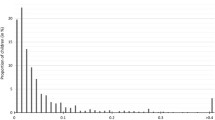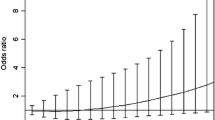Abstract
Causes of birth defects are unclear, and the association with electromagnetic fields is inconclusive. We assessed the relationship between residential proximity to extremely low frequency electromagnetic fields from power grids and risk of birth defects. We analyzed a population-based sample of 2,164,246 infants born in Quebec, Canada between 1989 and 2016. We geocoded the maternal residential postal code at delivery and computed the distance to the nearest high voltage electrical transmission line or transformer station. We used log-binomial regression to estimate risk ratios (RR) and 95% confidence intervals (CI) for the association of residential proximity to transmission lines and transformer stations with birth defects, adjusting for maternal and infant characteristics. The prevalence of birth defects within 200 m of a transmission line (579.4 per 10,000 per live births) was only slightly higher compared with distances further away (568.7 per 10,000). A similar trend was seen for transformer stations. Compared with 200 m, a distance of 50 m was not associated with the risk of birth defects for transmission lines (RR 1.00, 95% CI 1.00–1.01) and transformer stations (RR 1.01, 95% CI 1.00–1.03). There was no consistent association when we examined birth defects in different organ systems. We found no compelling evidence that residential proximity to extremely low frequency electromagnetic fields from electrical power grids increases the risk of birth defects. Women residing near electrical grids can be reassured that an effect on the risk of birth defects is unlikely.



Similar content being viewed by others
References
Toufaily MH, Westgate M-N, Lin AE, Holmes LB. Causes of congenital malformations. Birth Defects Res. 2018;110:87–91.
Weinhold B. Environmental factors in birth defects: what we need to know. Environ Health Perspect. 2009;117:A440–7.
Shaw GM, Croen LA. Human adverse reproductive outcomes and electromagnetic field exposures: review of epidemiologic studies. Environ Health Perspect. 1993;101:107–19.
Lewis RC, Hauser R, Maynard AD, Neitzel RL, Wang L, Kavet R, et al. Exposure to power-frequency magnetic fields and the risk of infertility and adverse pregnancy outcomes: update on the human evidence and recommendations for future study designs. J Toxicol Environ Health B Crit Rev. 2016;19:29–45.
Kurppa K, Holmberg PC, Rantala K, Nurminen T, Saxén L. Birth defects and exposure to video display terminals during pregnancy. A Finnish case-referent study. Scand J Work Environ Health. 1985;11:353–6.
Dlugosz L, Vena J, Byers T, Sever L, Bracken M, Marshall E. Congenital defects and electric bed heating in New York state: a register-based case-control study. Am J Epidemiol. 1992;135:1000–11.
Robert E. Birth defects and high voltage power lines: an exploratory study based on registry data. Reprod Toxicol. 1993;7:283–7.
Robert E, Harris JA, Robertt O, Selvin S. Case-control study on maternal residential proximity to high voltage power lines and congenital anomalies in France. Paediatr Perinat Epidemiol. 1996;10:32–8.
Blaasaas KG, Tynes T, Terje Lie R. Residence near power lines and the risk of birth defects. Epidemiology. 2003;14:95.
Blaasaas K, Tynes T, Lie R. Risk of selected birth defects by maternal residence close to power lines during pregnancy. Occup Environ Med. 2004;61:174–6.
Malagoli C, Rodolfi R, Fabbi S, Teggi S, Garavelli L, Astolfi G, et al. Residence near high-voltage power lines and risk of birth defects. Epidemiology. 2011;22:S124.
Ministry of Health and Social Services. Med-echo system normative framework—maintenance and use of data for the study of hospital clientele. Quebec: Government of Quebec; 2017.
Collège des médecins du Québec. La tenue des dossiers par le médecin en centre hospitalier de soins généraux et spécialisés. 2005. http://www.cmq.org/publications-pdf/p-1-2005-12-01-fr-tenue-des-dossiers-par-medecin-en-centre-hospitalier-de-soins-generaux-et-specialises.pdf. Accessed 11 Jan 2019.
Gilbert-Barness E. Teratogenic causes of malformations. Ann Clin Lab Sci. 2010;40:99–114.
Vistnes AI, Ramberg GB, Bjørnevik LR, Tynes T, Haldorsen T. Exposure of children to residential magnetic fields in Norway: is proximity to power lines an adequate predictor of exposure? Bioelectromagnetics. 1997;18:47–57.
Turgeon A, Bourdages M, Levallois P, Gauvin D, Gingras S, Deadman J-E, et al. Experimental validation of a statistical model for evaluating the past or future magnetic field exposures of a population living near power lines. Bioelectromagnetics. 2004;25:374–9.
Comité scientifique sur les champs électromagnétiques. Position des autorités de santé publique sur la gestion des champs magnétiques émis par les lignes électriques. Ministry of Health and Social Services. 2014. http://publications.msss.gouv.qc.ca/msss/document-001126/. Accessed 21 Sept 2018.
Gauvin D, Ngamga Djeutcha E, Levallois P. Exposition aux champs électromagnétiques: Mise à jour des risques pour la santé et pertinence de la mise en oeuvre du principe de précaution. Institut national de santé publique du Québec. 2006. https://www.inspq.qc.ca/pdf/publications/655-ChampsElectromagnetiques.pdf. Accessed 25 Sept 2018.
DMTI Spatial Inc. CanMap Content Suite data dictionary. 2016. http://canue.ca/wp-content/uploads/2018/03/Data_Dictionary_CanMap_Content_Suite_v2016_3.pdf. Accessed 10 Oct 2018.
HydroQuebec. The power system and health. Electric and magnetic fields. 2011. http://www.hydroquebec.com/fields/pdf/pop_23_01.pdf. Accessed 10 Jan 2019.
Public Health Agency of Canada. Congenital anomalies in Canada 2013: a perinatal health surveillance report. 2013. http://publications.gc.ca/site/eng/443924/publication.html. Accessed 5 Sept 2018.
Pampalon R, Hamel D, Gamache P, Philibert MD, Raymond G, Simpson A. An area-based material and social deprivation index for public health in Québec and Canada. Can J Public Health. 2012;103:S17–22.
Durrleman S, Simon R. Flexible regression models with cubic splines. Stat Med. 1989;8:551–61.
Deadman J-E, Plante M. Expositions aux champs magnétiques résidentiels au Québec. Institut national de santé publique du Québec. 2002. https://www.inspq.qc.ca/bise/expositions-aux-champs-magnetiques-residentiels-au-quebec. Accessed 25 Sept 2018.
Brent RL. Reproductive and teratologic effects of low-frequency electromagnetic fields: a review of in vivo and in vitro studies using animal models. Teratology. 1999;59:261–86.
Li D-K, Odouli R, Wi S, Janevic T, Golditch I, Bracken TD, et al. A population-based prospective cohort study of personal exposure to magnetic fields during pregnancy and the risk of miscarriage. Epidemiology. 2002;13:9–20.
Lee GM, Neutra RR, Hristova L, Yost M, Hiatt RA. A nested case-control study of residential and personal magnetic field measures and miscarriages. Epidemiology. 2002;13:21–31.
Li D-K, Chen H, Ferber JR, Odouli R, Quesenberry C. Exposure to magnetic field non-ionizing radiation and the risk of miscarriage: a prospective cohort study. Sci Rep. 2017;7:17541.
Su X-J, Yuan W, Tan H, Liu X-Y, Li D, Li D-K, et al. Correlation between exposure to magnetic fields and embryonic development in the first trimester. PLoS ONE. 2014;9:e101050.
Moorman A, Webb S, Brown NA, Lamers W, Anderson RH. Development of the heart: (1) formation of the cardiac chambers and arterial trunks. Heart. 2003;89:806–14.
Fell DB, Dodds L, King WD. Residential mobility during pregnancy. Paediatr Perinat Epidemiol. 2004;18:408–14.
Thomas EG, Higgins C, Westgate M-N, Lin AE, Anderka M, Holmes LB. Malformations surveillance: comparison between findings at birth and age 1 year. Birth Defects Res. 2018;110:142–7.
Acknowledgements
The authors thank Denis Gauvin for information on the electrical infrastructure in Quebec.
Funding
This work was supported by the Public Health Agency of Canada (6D02363004), the Canadian Institutes of Health Research (MOP-142277) and the Fonds de recherche du Québec-Santé (34695).
Author information
Authors and Affiliations
Corresponding author
Ethics declarations
Conflict of interest
The authors declare that they have no conflict of interest.
Ethical approval
The University of Montreal Hospital Centre’s Institutional Review Board waived the need for ethical review as the data were de-identified. All procedures performed in studies involving human participants were in accordance with the ethical standards of the institutional and/or national research committee and with the 1964 Helsinki declaration and its later amendments or comparable ethical standards. For this type of study formal consent is not required.
Additional information
Publisher's Note
Springer Nature remains neutral with regard to jurisdictional claims in published maps and institutional affiliations.
Electronic supplementary material
Below is the link to the electronic supplementary material.
Rights and permissions
About this article
Cite this article
Auger, N., Arbour, L., Luo, W. et al. Maternal proximity to extremely low frequency electromagnetic fields and risk of birth defects. Eur J Epidemiol 34, 689–697 (2019). https://doi.org/10.1007/s10654-019-00518-1
Received:
Accepted:
Published:
Issue Date:
DOI: https://doi.org/10.1007/s10654-019-00518-1




